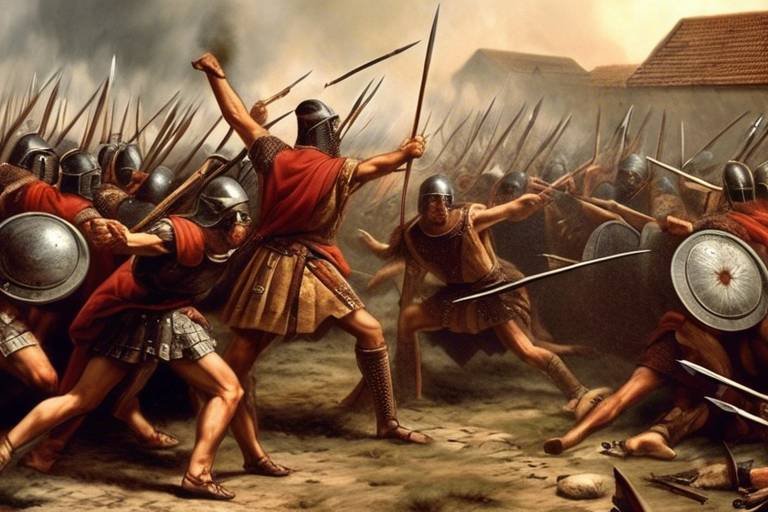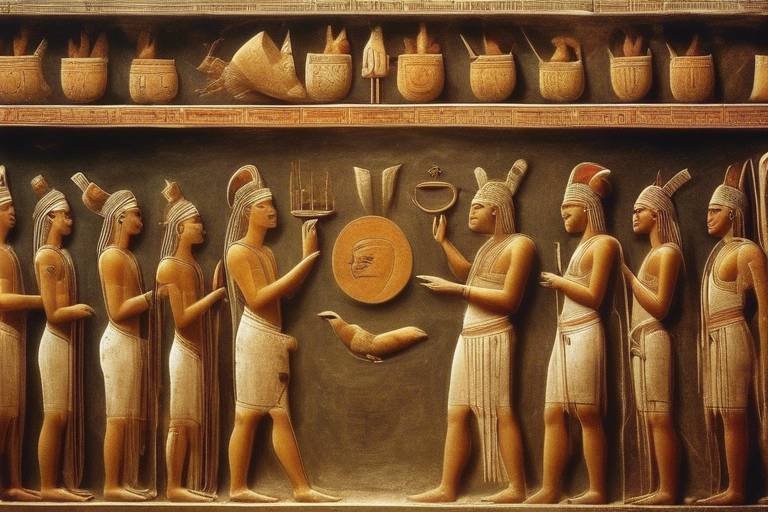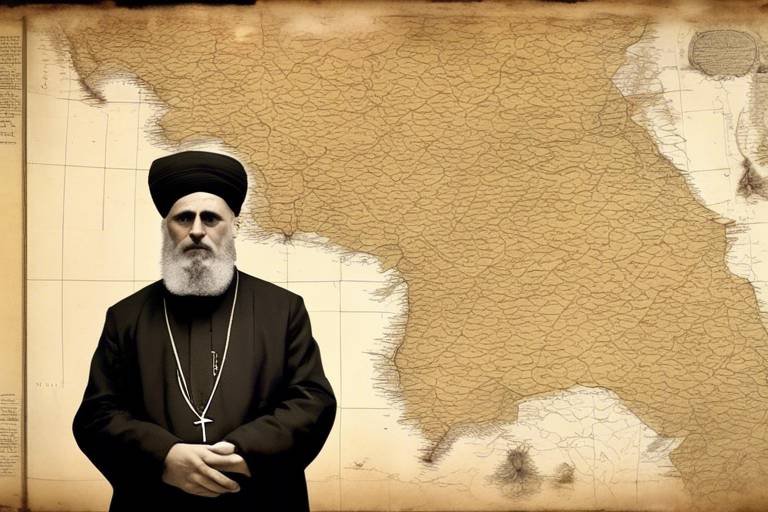Ancient Warfare - Lessons from History
Ancient warfare holds a treasure trove of knowledge and wisdom waiting to be unearthed. By delving into the strategies, tactics, and outcomes of battles fought in antiquity, we can glean valuable insights that are applicable to modern military practices and conflict resolution. The echoes of history reverberate through time, offering us a window into the past to learn from the triumphs and tribulations of ancient warriors.

Importance of Studying Ancient Warfare
Exploring the strategies, tactics, and outcomes of ancient warfare to draw insights and lessons that can be applied to modern military practices and conflict resolution.
Studying ancient warfare is like delving into a treasure trove of strategic wisdom and historical significance. By immersing ourselves in the battles and conflicts of antiquity, we gain a profound understanding of how past events have shaped the military landscape of today. Just as a painter learns from the masters of old, military professionals and historians can glean invaluable lessons from the tactics and strategies employed by ancient civilizations.
Analyzing renowned battles such as Thermopylae, Cannae, and Gaugamela unveils a tapestry of military brilliance and innovation. From the legendary stand of the Spartans at Thermopylae to the tactical genius of Hannibal at Cannae, these battles serve as timeless examples of strategic prowess and adaptability in the face of adversity.
The evolution of weaponry and military technology in ancient warfare is a testament to human ingenuity and innovation. From the humble sword and spear to the mighty siege engines and naval vessels, ancient civilizations continuously pushed the boundaries of military technology to gain the upper hand on the battlefield.
Ancient armies faced daunting logistical challenges in terms of manpower, provisions, and resource transportation. The ability to efficiently manage and sustain supply lines often determined the success or failure of military campaigns, highlighting the crucial role of logistics in ancient warfare.
The leadership and command structure of ancient military organizations played a pivotal role in shaping battlefield outcomes. From the charismatic generals of Rome to the disciplined phalanx formations of Greece, effective leadership and hierarchical organization were fundamental to achieving victory in ancient conflicts.
Ancient civilizations constantly adapted their strategies and tactics in response to changing warfare dynamics and technological advancements. The ability to innovate and evolve in the face of new challenges allowed ancient armies to stay ahead of their adversaries and secure military supremacy.
The legacy of ancient warfare continues to reverberate in contemporary military thinking, conflict resolution, and geopolitical strategies. Lessons learned from the battles of old still hold relevance in today's world, shaping the way modern military professionals and policymakers approach conflicts and strategic decision-making.
By drawing parallels between ancient and modern warfare, we can extract valuable insights and lessons for military professionals, policymakers, and historians in the present day. The timeless principles of strategy, leadership, and innovation gleaned from ancient warfare can provide a guiding light in navigating the complexities of modern conflicts and security challenges.

Key Battles and Tactics
Exploring the strategies, tactics, and outcomes of ancient warfare to draw insights and lessons that can be applied to modern military practices and conflict resolution.
Understanding the historical context and significance of ancient battles and conflicts in shaping military strategies and doctrines today.
When delving into the annals of ancient warfare, one cannot overlook the pivotal battles that have left a lasting mark on military history. Battles such as Thermopylae, where a small Spartan force held off the mighty Persian army under Xerxes, showcase the power of strategic positioning and defensive tactics. Hannibal's masterful maneuver at Cannae, encircling and decimating a larger Roman army, demonstrates the importance of exploiting enemy weaknesses. Alexander the Great's victory at Gaugamela, utilizing innovative tactics and superior cavalry, highlights the impact of bold and decisive leadership on the battlefield.
Examining the evolution of weaponry and military technology used in ancient warfare, from swords and spears to siege engines and naval vessels.
Investigating the logistical challenges faced by ancient armies in terms of manpower, provisions, and transportation of resources.
Evaluating the role of leadership, hierarchy, and command structure in ancient military organizations and their impact on battlefield outcomes.
Exploring how ancient civilizations adapted their strategies and tactics in response to changing warfare dynamics and technological advancements.
Reflecting on the enduring influence of ancient warfare on contemporary military thinking, conflict resolution, and geopolitical strategies.
Drawing parallels between ancient and modern warfare to extract valuable lessons for military professionals, policymakers, and historians in today's world.
Stay tuned for answers to common queries about ancient warfare and its relevance to modern military practices!

Weapons and Technology
When delving into the realm of ancient warfare, one cannot overlook the remarkable evolution of weaponry and military technology that shaped the outcomes of historical battles. From the simplicity of swords and spears to the complexity of siege engines and naval vessels, ancient civilizations displayed ingenuity and innovation in their quest for military supremacy.
One of the most iconic weapons of ancient warfare was the Roman gladius, a short sword wielded by legionnaires with deadly precision in close combat. Its design allowed for swift and decisive strikes, making it a formidable weapon on the battlefield. Additionally, the Roman scutum, a large rectangular shield, provided crucial protection to soldiers, illustrating the importance of defensive capabilities in ancient warfare.
Moreover, the advancements in military technology during ancient times extended beyond handheld weapons. Siege engines such as ballistae and catapults revolutionized the art of warfare by enabling armies to breach fortified walls and lay siege to enemy strongholds. These formidable machines required skilled operators and precise coordination to unleash devastation upon enemy defenses.
Naval warfare also witnessed significant technological advancements in ancient times, with warships ranging from sleek triremes to massive galleys dominating the seas. The Phoenicians, renowned for their maritime prowess, developed innovative ship designs and navigation techniques that allowed them to control vital trade routes and project power across the Mediterranean.
Furthermore, the utilization of military technology in ancient warfare was not limited to offensive capabilities. Defensive structures such as city walls, fortresses, and barricades played a crucial role in protecting territories and repelling enemy invasions. The construction of these defensive works required immense manpower and engineering expertise, showcasing the strategic importance of fortifications in ancient military campaigns.
In essence, the study of weapons and technology in ancient warfare offers a glimpse into the ingenuity and resourcefulness of past civilizations in their quest for military dominance. By analyzing the evolution of weaponry, the development of military technology, and the strategic use of defensive structures, modern military professionals can draw valuable insights and lessons to enhance their own tactical capabilities and strategic planning.

Logistics and Supply Lines
Exploring the strategies, tactics, and outcomes of ancient warfare to draw insights and lessons that can be applied to modern military practices and conflict resolution.
Logistics and supply lines played a crucial role in the success or failure of ancient armies. Imagine an army marching towards battle, equipped with the finest weapons and skilled soldiers, only to falter due to lack of provisions or inefficient transportation of resources. The logistical challenges faced by ancient armies were immense, requiring meticulous planning and execution.
Ancient commanders had to ensure a steady supply of food, water, and equipment for their troops, often over long distances and through hostile territories. This involved organizing convoys of wagons, pack animals, and boats to transport supplies efficiently. Without proper logistics, even the most brilliant military strategies could crumble.
Moreover, the manpower needed to sustain an army was staggering. Thousands of soldiers required food, shelter, and medical care, placing immense pressure on supply lines. Inadequate logistics could lead to desertion, mutiny, or defeat on the battlefield.
To overcome these challenges, ancient civilizations developed sophisticated supply networks and storage facilities. They established depots along their routes, stockpiling provisions and creating buffer stocks to prevent shortages. This foresight and planning were essential for maintaining the fighting strength of their armies.
Additionally, the transportation of resources, such as siege engines, artillery, and war materials, posed another logistical hurdle. Ancient engineers devised innovative solutions, including the use of specialized carts, sledges, and cranes to move heavy equipment efficiently. The success of sieges and battles often hinged on the timely arrival of these critical assets.
In essence, logistics and supply lines were the lifeblood of ancient warfare, sustaining the operational capabilities of armies and enabling them to project power across vast distances. By studying how ancient civilizations managed these challenges, modern military planners can glean valuable insights into the importance of robust logistical support in achieving strategic objectives.
Q: How did ancient armies deal with supply shortages during campaigns?
A: Ancient armies often resorted to foraging, plundering, or negotiating with local populations for supplies. However, these methods were unreliable and unsustainable in the long run.
Q: Were there specialized units dedicated to logistics in ancient armies?
A: Yes, ancient armies had quartermasters, commissariat officers, and logistical specialists responsible for managing supply chains and ensuring the smooth functioning of logistics.
Q: What role did geography play in shaping logistics for ancient armies?
A: Geography heavily influenced logistical planning, as terrain, climate, and distance impacted the feasibility of supply routes and the availability of resources along the way.

Leadership and Command Structure
Leadership and command structure played a pivotal role in ancient warfare, often determining the outcome of battles and campaigns. In civilizations such as ancient Rome, Greece, and Persia, the hierarchy within the military was well-defined, with clear chains of command from the top generals down to the common soldiers. Commanders like Alexander the Great and Julius Caesar were not only skilled tacticians but also charismatic leaders who inspired loyalty and obedience among their troops.
One key aspect of ancient leadership was the concept of leading by example. Generals would often fight alongside their soldiers on the front lines, showcasing bravery and determination to boost morale and demonstrate their commitment to victory. This hands-on approach to leadership fostered a strong sense of camaraderie and unity within the ranks, enhancing overall effectiveness in battle.
Moreover, the command structure in ancient armies was designed to ensure efficient communication and coordination on the battlefield. Signal systems, such as flags, horns, and drums, were used to convey orders swiftly across large distances, allowing for rapid deployment and maneuvering of troops. This emphasis on clear communication and swift decision-making was crucial in the fast-paced and chaotic environment of ancient warfare.
Another critical aspect of leadership in ancient military organizations was the delegation of authority. Generals would appoint trusted officers to oversee specific units or aspects of the army, empowering them to make crucial decisions in the heat of battle. This decentralized command structure allowed for more flexibility and adaptability, enabling armies to respond effectively to changing circumstances and enemy tactics.
Overall, the leadership and command structure in ancient warfare exemplified the importance of strong leadership, effective communication, and strategic delegation of authority. These principles continue to resonate in modern military practices, highlighting the enduring legacy of ancient commanders and their innovative approaches to leading armies into battle.

Strategic Adaptation and Innovation
When we delve into the annals of ancient warfare, one of the most intriguing aspects is the strategic adaptation and innovation displayed by civilizations facing new challenges. Imagine ancient generals like chess masters, constantly assessing the battlefield, anticipating their opponent's moves, and devising innovative strategies to outmaneuver their foes. It's akin to a high-stakes game of strategy where the slightest miscalculation could lead to defeat.
Take, for example, the Roman military, known for its remarkable ability to adapt to different terrains and enemy tactics. From the innovative use of the 'testudo' formation for protection to the development of the highly effective 'pilum' javelin, the Romans were masters of strategic innovation. They understood that flexibility and quick thinking were crucial in the ever-changing landscape of warfare.
Similarly, ancient Chinese military strategist Sun Tzu emphasized the importance of adaptability and innovation in his timeless work, 'The Art of War.' He famously said, "In the midst of chaos, there is also opportunity." This mindset of turning adversity into advantage through strategic thinking resonates across centuries and remains relevant in the modern world.
Moreover, the concept of innovation in ancient warfare extended beyond tactics to technology. The invention of siege engines like catapults and ballistae revolutionized the way battles were fought, allowing armies to breach fortified walls and gain strategic advantages. Naval innovations, such as the trireme warships of ancient Greece, transformed naval warfare and expanded the reach of empires across the seas.
Adaptation and innovation were not just tactical choices but strategic imperatives for ancient civilizations facing formidable adversaries. Whether it was the Macedonians under Alexander the Great adapting to diverse terrains or the Carthaginians under Hannibal utilizing elephants in unexpected ways, the ability to think outside the box often determined the outcome of pivotal battles.
In essence, studying the strategic adaptation and innovation of ancient warfare offers a treasure trove of insights for modern military leaders and strategists. By understanding how past civilizations navigated challenges, embraced change, and leveraged innovation, we can glean valuable lessons applicable to contemporary conflict scenarios. The legacy of ancient warfare serves as a timeless reminder that strategic agility and innovative thinking are key to achieving victory on the battlefield.

Legacy of Ancient Warfare
Ancient warfare has left a lasting legacy that continues to shape modern military thinking and strategies. The lessons learned from the battles fought by ancient civilizations have had a profound impact on contemporary conflict resolution and geopolitical strategies. By studying the tactics, strategies, and outcomes of ancient warfare, we can gain valuable insights into the art of war and its enduring influence on military practices.
One of the key aspects of the legacy of ancient warfare is the emphasis on strategic thinking and adaptability. Ancient commanders were adept at adjusting their tactics in response to changing battlefield conditions and technological advancements. Their ability to innovate and adapt to new challenges remains a timeless lesson for modern military professionals.
Furthermore, the leadership and command structures of ancient armies offer valuable lessons in organizational hierarchy and decision-making. Understanding how ancient civilizations structured their military organizations can provide insights into effective leadership and the importance of clear communication on the battlefield.
Moreover, the legacy of ancient warfare extends to the realm of logistics and supply lines. Ancient armies faced significant challenges in terms of manpower, provisions, and transportation of resources. By examining how these challenges were overcome or sometimes led to defeat, modern military planners can learn valuable lessons in logistical planning and resource management.
Lastly, the enduring influence of ancient warfare can be seen in the strategic thinking of contemporary military leaders and policymakers. The parallels between ancient and modern warfare highlight the timeless principles of warfare that transcend time and technology. By reflecting on the legacy of ancient warfare, we can gain a deeper understanding of the complexities of conflict and the importance of learning from history.

Lessons for Modern Warfare
Exploring the strategies, tactics, and outcomes of ancient warfare to draw insights and lessons that can be applied to modern military practices and conflict resolution.
When we delve into the annals of ancient warfare, we unearth a treasure trove of wisdom that resonates even in the modern battlefield. The echoes of battles fought on dusty plains and rugged terrains reverberate through time, offering invaluable lessons for contemporary military strategists and leaders.
One of the paramount lessons from ancient warfare is the significance of adaptability and flexibility in the face of evolving threats. Just as ancient generals adjusted their tactics to counter new technologies and strategies, modern military commanders must remain agile and responsive to the changing dynamics of warfare.
Moreover, the emphasis on leadership and command structure in ancient armies serves as a timeless reminder of the pivotal role played by decisive leadership on the battlefield. The legacy of great military leaders like Alexander the Great and Julius Caesar underscores the importance of visionary leadership in achieving strategic objectives.
Furthermore, the study of ancient warfare highlights the critical importance of intelligence gathering and reconnaissance in shaping military operations. From the scouts of antiquity to modern-day surveillance technologies, the ability to gather timely and accurate information remains a cornerstone of effective military planning.
Additionally, the concept of unity of command, where all forces operate under a single coordinated effort, emerges as a fundamental principle drawn from ancient military campaigns. The coordination of land, air, and sea forces in a unified strategy mirrors the integrated approach employed by ancient empires to achieve battlefield success.
In essence, the lessons gleaned from ancient warfare transcend the boundaries of time and geography, offering a timeless blueprint for success in modern military endeavors. By studying the strategies, tactics, and innovations of our predecessors, we equip ourselves with a deeper understanding of the art and science of warfare, ensuring that history's lessons are not lost in the mists of time.
Frequently Asked Questions
- What can we learn from studying ancient warfare?
Studying ancient warfare provides valuable insights into the strategies, tactics, and leadership styles that shaped historical battles. By understanding how ancient civilizations approached conflict, we can draw parallels to modern military practices and gain a deeper appreciation for the evolution of warfare over time.
- Which ancient battles are considered pivotal in military history?
Battles such as Thermopylae, Cannae, and Gaugamela are often highlighted for their strategic significance and innovative tactics employed by ancient commanders. These engagements continue to be studied for the lessons they offer in terms of military strategy, leadership, and battlefield maneuvering.
- How did ancient armies manage logistics and supply lines?
Ancient armies faced considerable challenges in maintaining adequate provisions, manpower, and transportation of resources during campaigns. Understanding the logistical strategies employed by ancient civilizations sheds light on the importance of supply chains in sustaining military operations throughout history.
- What is the legacy of ancient warfare on modern military thinking?
Ancient warfare has left a lasting impact on contemporary military thought, influencing concepts of leadership, strategic adaptation, and conflict resolution. By examining the legacy of ancient battles, we can gain a deeper understanding of the historical roots of modern military practices and doctrines.



















